The Software “RP Q-switch”
A Convenient Tool for Designing Q-Switched Lasers
The software package RP Q-switch has been developed for calculations on actively or passively Q-switched solid-state lasers, and of spiking phenomena in continuous-wave lasers. Based on given parameters of the laser resonator and the gain medium, it numerically simulates the evolution of the laser power and calculates the parameters of generated pulses. The software is a valuable tool particularly for the design of actively or passively Q-switched solid-state lasers. (For fiber lasers, and in some cases even for bulk lasers, the software RP Fiber Power is more suitable.) It can also be used for educational purposes. For example, a laser designer can develop a deeper understanding of Q-switched lasers by working with this simulation software.
The software can be used for addressing the following kinds of questions, for example:
- Is the experimentally observed performance of my Q-switched laser (including pulse energy and duration, double pulsing, etc.) in agreement with theoretical expectations?
- If not, which deviations of parameters could explain that?
- What are the prospects for better performance resulting from considered design changes?
- Is my Q switch fast enough, and is its hold-off sufficient? If not, how much better would it have to be to solve my problems?
- Is it possible to find a laser design which gives me three times shorter pulses? What limits the achievable pulse duration?
- Can one get an improved frequency doubling conversion efficiency by inserting a frequency doubler in the laser resonator (rather than externally)? To what extent will this make the pulses longer? Which value of low-intensity conversion efficiency (in %/W) would be ideal?
User licenses are available both for commercial application in laser companies and for universities and other educational institutions. Contact RP Photonics to inquire about the conditions.
Key Features
- The user can define an arbitrary sequence of the following kinds of intracavity optical elements: laser crystal, output coupler mirror, modulator (active Q switch), saturable absorber (passive Q switch), and parasitic losses.
- Both four-level lasers and quasi-three-level lasers can be treated. This means that the software can also be applied to Yb:YAG lasers, for example.
- There can also be up to three different amplification stages outside the laser resonator. Their saturation characteristics are modeled in detail.
- The software can calculate pulse parameters like energy, peak power, duration, and temporal position. Also, it can be used for monitoring various other parameters of interest for the laser engineer, such as the temporal evolution of the laser gain or the bleaching of a saturable absorber.
- For continuous-wave lasers, spiking and relaxation oscillations can be investigated.
- The pump power may be modulated with several formats (e.g. rectangular, sinusoidal, or saw tooth).
- Various unwanted phenomena can be studied in detail, e.g. performance degradation due to limited modulator speed, multiple pulses for too long opening time of the modulator, etc.
- Input and output of parameters is done via a convenient form, so that it is very easy for new users to get started.
- The software can generate graphical output, which can be controlled in a very flexible way. There are eight predefined kinds of graphs, and the users can define many other kinds of plots (including parametric ones) themselves.
- It is also possible to write tabulated data to a text file. In this way, data can be exported for further processing with other software.
If required, RP Photonics can develop special versions with additional features.
RP Q-switch runs on a PC under Windows XP or later.
Limitations and a Possible Alternative
A fundamental limitation of RP Q-switch is that it does not take into account the transverse dependencies. Effectively, it assumes top-hat beam profiles, i.e., that the intensities is constant within a certain radius and zero outside. That approximation is acceptable in many cases, but not always.
For more sophisticated simulations, we recommend to use the software RP Fiber Power. Although that software has been designed for use with fiber lasers, it can also be applied to most end-pumped bulk lasers. RP Fiber Power can fully take into account the transverse profiles of field intensities and doping concentration, and it can treat complicated energy level schemes. Also, the flexibility is substantially higher than that of RP Q-switch. For example, RP Fiber Power can handle arbitrary time dependencies of pump powers and signal inputs and a wider range of graphical diagrams. For these reasons, RP Fiber Power is recommended for more sophisticated simulations, whereas RP Q-switch is the right tool for very quickly getting results in simpler situations.
Documentation
The RP Q-switch software comes with detailed documentation. The running software can display the full documentation or detailed information on particular input or output fields of the forms (see below).
License Conditions
Contact RP Photonics to learn about license conditions. The commercial software license includes up to eight working hours of support, to be used on technical issues with the software and the underlying model, or for advice on laser dynamics, Q-switched laser design, and alike.
This software is further improved from time to time. Customers in possession of a license will usually obtain updated versions without paying any additional fees.
Note that buying a license is not the only possibility: you may also let RP Photonics do the calculations. You will then receive the calculated results together with interpretations and resulting recommendations e.g. for your laser design. You then only pay for the work on an hourly basis, but don't require a software license yourself, nor the time to learn the details.
Screen Shot
The figure below shows a screen shot of the main form of RP Q-switch. The user does not need to learn some command syntax, but simply has to fill the data into the given fields. A brief description of the meaning of an input field is given in the status line (at the bottom); longer texts can be displayed by pressing the Shift-F1 key.
There are separate forms for the parameter of the gain medium and for the parameters of the external amplifier stages.
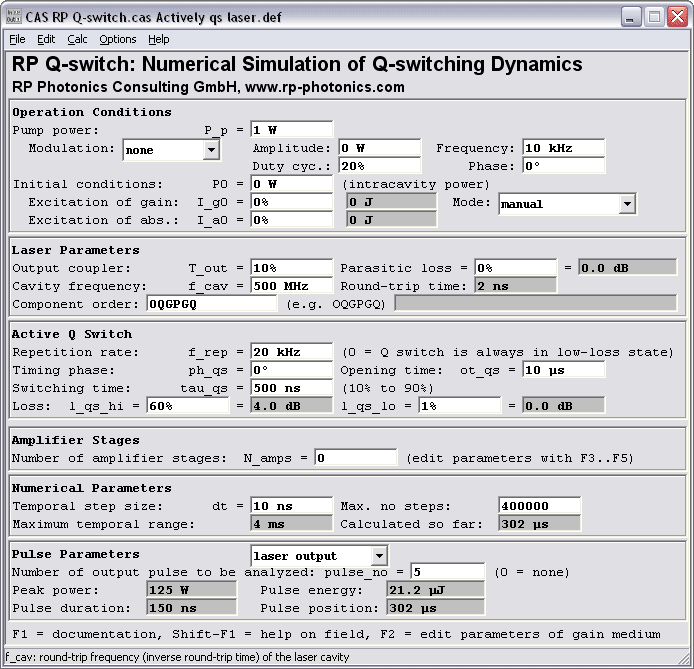
(Here, the panel "Passive Q switch" is hidden, because in the field "component order" no "A" for "absorber" has been included.)
Examples for Graphical Output of RP Q-switch
The following diagrams all apply to the example of an actively Q-switched Nd:YAG laser.
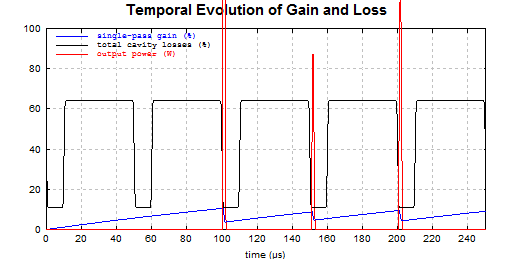
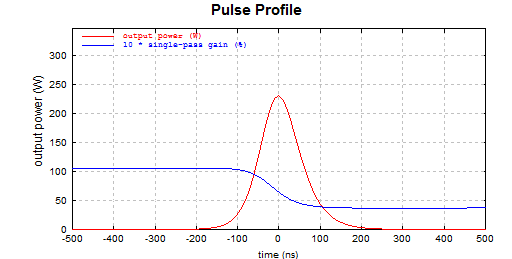
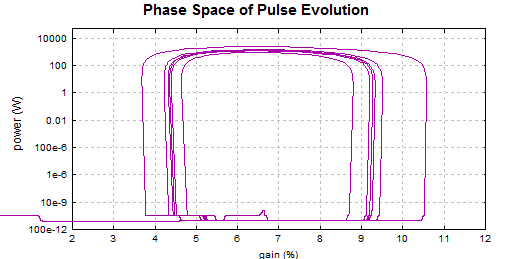
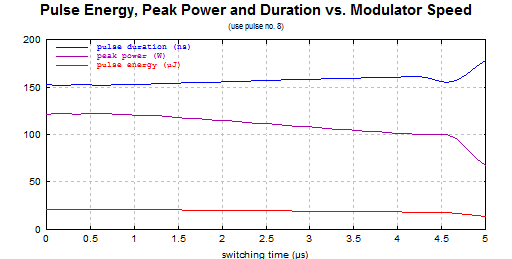
If you have any further questions or need a quotation:
